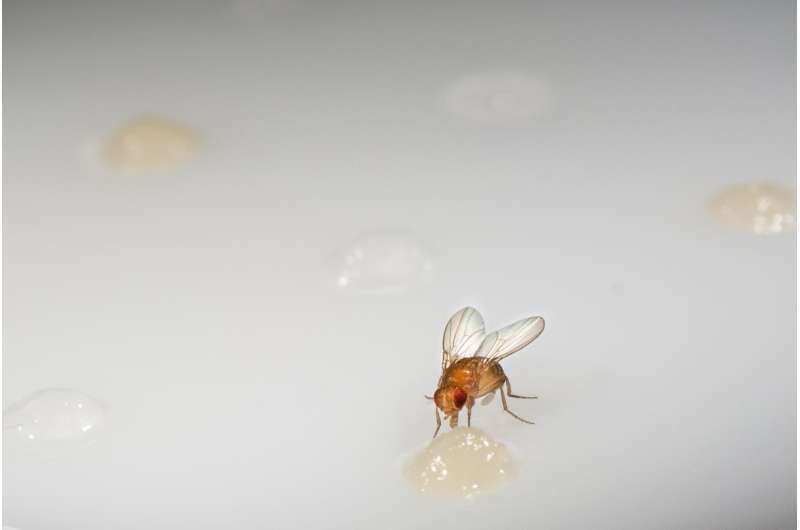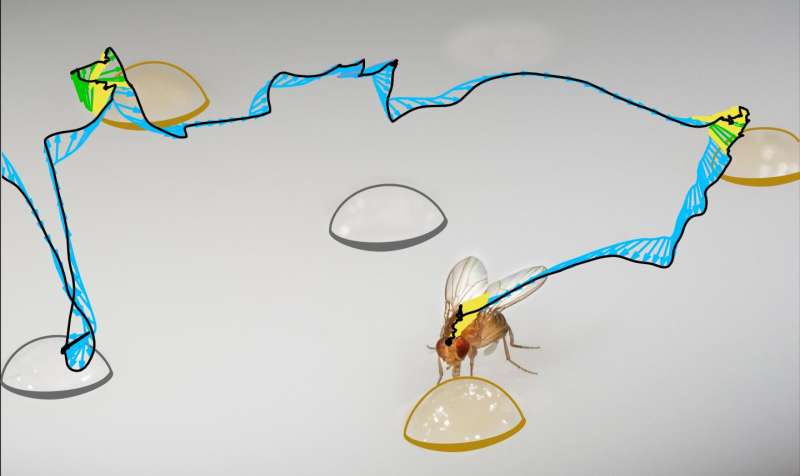Identifying the brain mechanisms behind changes in feeding habits

Fruit flies deprived of specific essential nutrients alter their food choices—and even the way they search for food. A team of neuroscientists, led by researchers from the Champalimaud Foundation in Lisbon, Portugal, "dissected" these behaviors, a first step toward identifying the brain mechanisms that are behind these changes in feeding habits.
When standing before an array of delicious-looking dishes displayed on a buffet, some of us will choose grilled fish with salad, while others will go for the fried chicken with french fries. Individual choices are hugely variable—and when they are unhealthy, making them over and over again can have harmful consequences for our health.
What makes an organism choose one type of food over another? More specifically, could it be that the lack of certain nutrients alters its behavior, thus influencing food choices? That is the question that Carlos Ribeiro and Verónica Corrales-Carvajal, at the Champalimaud Foundation in Lisbon, together with Aldo Faisal, from Imperial College London, set out to answer. Their conclusions have just been published in the journal eLife.
It is widely acknowledged that many organisms including humans are able to choose foods according to the nutrients they need without being aware of doing so. This aspect of behavior has been much studied in the tiny fruit fly, but only superficially, says Carlos Ribeiro, who led the new study. "We know that when fruit flies are on an amino acid-deprived diet [amino acids are the building blocks of proteins], they will eat more protein," he explains.
Now, thanks to an extremely precise computerized visualization technique developed by co-author Verónica Corrales-Carvajal, the team was able to very finely "dissect" this behavior.
In these experiments, each fly had easy access to two distinct types of food: sugar (containing no protein) and protein-rich yeast. These foods were distributed in small drops across an arena that the fly could explore. Its movements were then recorded for two hours by a video camera and stored for later analysis.
"The biggest technical challenge was to extract the information hidden in the data," says Verónica Corrales-Carvajal. "We were in uncharted territory. There was neither a right nor a wrong way to extract this information that couldn't be seen with the naked eye in order to extract meaning from behavior. All we had was a sequence of the fly's positions over time. We had to create algorithms to visualize the data in different ways in order to answer particular questions about what the flies were exactly doing with respect to the nutrients available and at different time scales. We spent a considerable amount of time looking at the raw data, allowing our brains to find interesting patterns."

In this way, the scientists were able to compare the behavior of flies that started in different nutritional "internal states." Some had been on a diet totally deficient in amino acids, others on a diet containing amino acids but in the wrong proportions, and still others on a balanced amino acid diet. And they found that the nutritional state of the flies affected their feeding behavior patterns.
One of the most interesting results, says Carlos Ribeiro, was that the lack of amino acids in their diet make flies "more conservative, less inclined to take risks." Specifically, flies that were getting sufficient amino acids from their diet displayed a stronger propensity to explore other areas of the arena and search for other spots containing food. But flies that were deprived of amino acids ate mostly yeast, and even when they decided to search elsewhere for this food, they repeatedly returned to the spot where they already knew yeast was available.
"The alteration of risk-taking behaviors under the influence of diet can have profound implications, affecting exploration behaviors not related to food seeking," adds Carlos Ribeiro. "It is likely a more general phenomenon, also taking place in other contexts."
Nonetheless, the authors also observed that, apart from the flies that had been totally deprived of amino acids (which, for the most part, behaved in a similar way), the craving for yeast showed a "huge variability" among the rest of the insects—from total indifference to a strong eagerness to eat this food.
This finding prompted another question: Is this variability random, or is each fly reacting in a individualized, "idiosyncratic" manner? If the latter is true, it could mean that the diversity of the flies' reactions reflects the diversity of their individual characteristics, whether physiological (metabolic), related to the microbiome (gut bacteria), or neural.
Similarly, humans react in very different ways to the same food: "The glucose levels of some people skyrocket when they eat a banana, while in others it drops," says Carlos Ribeiro.
Those differences can actually be very extreme, making some of us virtually "immune" to gaining weight while ingesting huge portions of all kinds of food; others seem to gain weight just by looking at a dish. So understanding individual variability in metabolism and feeding behavior might enable us to better deal with human diseases such as obesity and diabetes.
More information: Verónica María Corrales-Carvajal et al. Internal states drive nutrient homeostasis by modulating exploration-exploitation trade-off, eLife (2016). DOI: 10.7554/eLife.19920
Journal information: eLife
Provided by MIT-Portugal Program




















